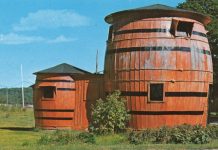
At the beginning of the 20th century, picture postcards were becoming a social phenomenon. Common scenes included town views, buildings and events. The accessibility of burgeoning photography technology merged with American ingenuity and “tall-tale” postcards were created. Also called “exaggeration” and “freak,” they came on the scene about 1910.
It’s easy to see the link between folk tales, like those of Paul Bunyan, and pictorial tall-tale scenes represented on postcards. The cards follow an American tradition of yarns and lies, perhaps like the tales heard from fishermen in taverns of sightings and close calls.
The postcards juxtaposed out-of-scale images with ordinary objects. Common depictions might include a giant ear of corn filling a flatbed railcar, or a cowboy riding on a monstrous grasshopper. In the days long before Photoshop, viewers did a double-take looking at these novelty cards, for wasn’t it a fact that photography didn’t lie?
Accurate joining and photographic juxtaposition are the careful techniques that try to make these postcard scenes believable. We know that a Michigan fish can’t be that enormous, but the cards were photographic evidence of “the kind we catch here.”
Images of “the fish that got away” were well-liked by the public. Since Michigan is a hot spot for fishing, it’s no wonder that these exaggerated fishing postcards were in “big” demand. America’s spirit of boosterism prevailed in showing off the “biggest” of everything. Boosterism also is part of Michigan’s fishing culture. Think of taverns up north where the biggest local catches are mounted with pride for customers to see.

The photographic versions of these postcards were popular in the first decades of the 1900s. Drawn or painted images came later, in the 1930s and 1940s. Portraying action and excitement, the artistic renderings made viewers skeptical, but nonetheless they were humorous and captivating.
A few national postcard publishers produced the majority of these tall-tall postcards. Curt Teich of Chicago sold a series called “Big Fish Comics.” Another big national printer was E.C. Kropp of Milwaukee. The Midland Publishing Company of New York copyrighted the trick photography of J. Herman in 1912-1913 and the L. Black Company of Detroit did the same for its work in 1918. Other Michigan companies that printed them included the Upper Michigan Card Company in Manistique and Outdoor Sports Cards in Alpena. Some publishers remained anonymous, with no indication on the back of who printed them. A popular series labeled “Freak Fish” only indicated that they were “made in the USA.”
Humor was a preferred theme on the front of these novelty postcards, but messages on the back often had a light-heartedness, too.
A message on the back of a card from Lake George, Michigan, in 1916 showing five men attacking a giant fish with pikes said: “This is the way we catch fish here. Some fish, eh!”
Another mailed in 1917 portrayed a giant fish on a flatbed railcar from Manton. It read “Hoping you might come and help eat our fish.”

A card postmarked Shelby 1910, showing a jumping fish knocking over the fisherman in his boat, said: “This is the way they jump in Stony Lake.”
From Traverse City in 1936, a card showing an enormous fish three times the size of the fishing boat claims: “This is the one Daddy didn’t catch.”
As P.T. Barnum conveyed in his life’s work, the public likes to be fooled, as long as they’re amused in the process. Today, these larger-than-life fish postcards continue to amuse us with their absurdity. ≈
BLUE Vintage Views columnists M. Christine Byron and Thomas R. Wilson reside in Grand Rapids. They are authors of the book “Historic Leelanau: Recognized Sites and Places of Historical Significance.”
* Photography Courtesy Vintage Views







Facebook Comments